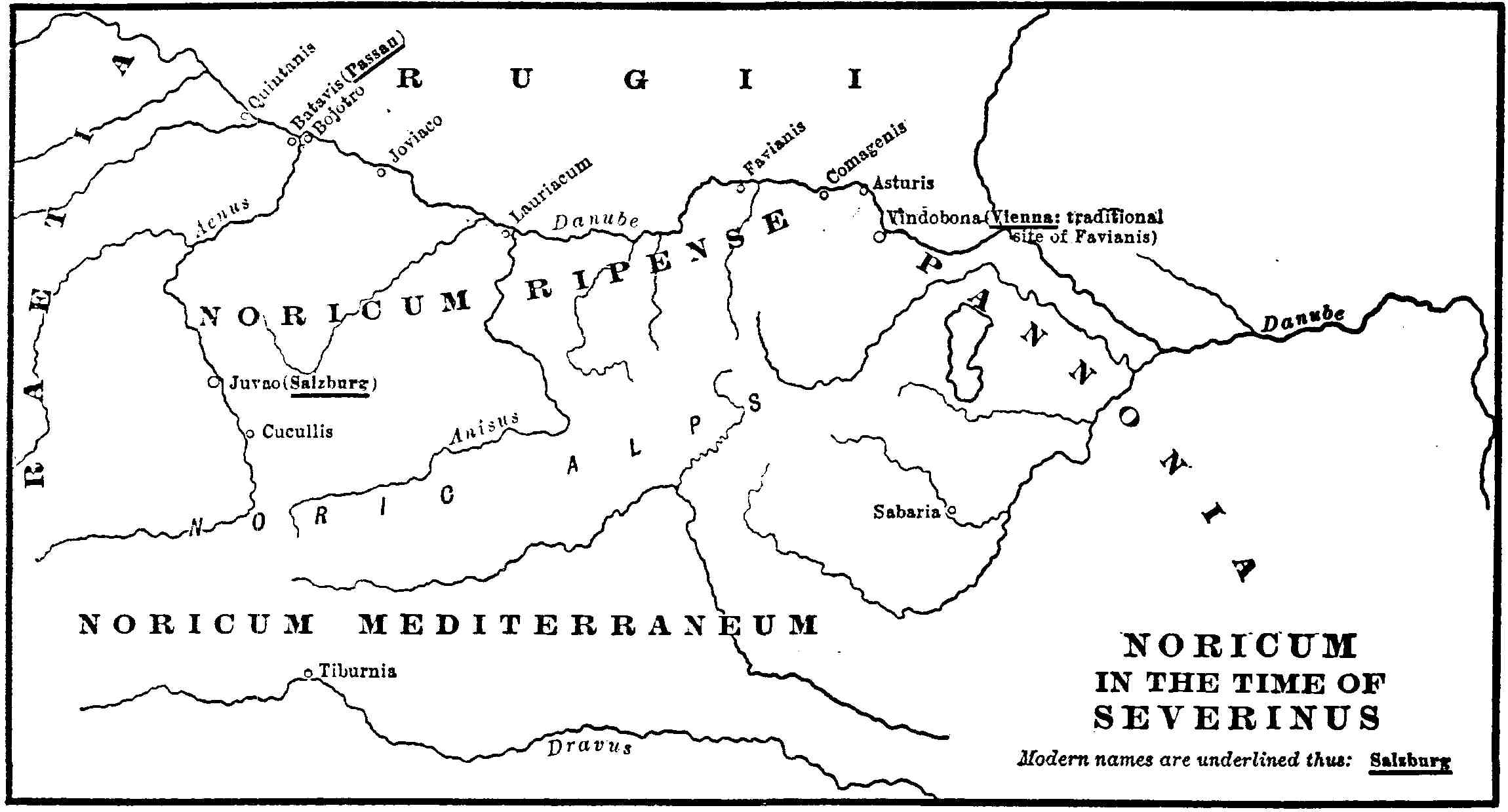Eugippius, The Life of St. Severinus (1914) pp. 1-11. Title page and introduction.

THE LIFE OF SAINT SEVERINUS
BY
EUGIPPIUS
TRANSLATED INTO ENGLISH FOR THE FIRST TIME
WITH NOTES
BY
GEORGE W. ROBINSON
SECRETARY OF THE HARVARD GRADUATE SCHOOL OF
ARTS AND SCIENCES
'Severin: eine Persönlichkeit, zu der es keine Parallele giebt."
Hauck,
Kirchengeschichte Deutschlands, vol.i, p. 330.
CAMBRIDGE
HARVARD UNIVERSITY PRESS
LONDON: HUMPHREY MILFORD
OXFORD UNIVERSITY PRESS
1914
COPYRIGHT, 1914
HARVARD UNIVERSITY PRESS
MANIBUS
GUILIELMI WATSON GOODWIN
ADAMS SHERMAN HILL
JACOBI BRADSTREET GREENOUGH
CLEMENTIS LAURENTII SMITH
ΤΩΝ MAKAΡITΩN SACRUM
It has been said of the French, and might with equal truth be said of the Germans, that they make all excellent pieces of antiquity their own. That we are yet far from being in a position to make the same boast in behalf of our noble English tongue; that our deficiency is particularly great as respects the last centuries of ancient civilization, which have so immediate a relation to the mediaeval and modern worlds; and that in those centuries it would be difficult to find a writing more worthy of introduction to English readers than the work which Teuffel terms "the incomparable biography of Saint Severinus": these facts, I trust, may be considered in some measure to justify the present publication.
This translation of the Life of Severinus, the first, so far as appears, in our language,1 is from the recension of the text by Theodor Mommsen, published at Berlin, in 1898, in the series of Scriptores Rerum |8 Germanicarum. In an Appendix, pp. 117-121 below, I have given a list of editions and translations. Mommsen's preface contains an account of the manuscripts of the Life, of the chronology of the time, so far as it casts direct light upon the careers of Severinus and Eugippius, and of the references to Eugippius and Severinus in later ecclesiastical writers.2 One who desires a more general view of the period may obtain it by reading the pertinent chapters of Hodgkin, Dahn, or Gibbon, or Julius von Pflugk-Harttung's The Great Migrations, which, translated from the Allgemeine Weltgeschichte, forms the sixth volume in Wright's History of All Nations. Passages referring specifically to Severinus may be found in Pflugk-Harttung's volume, in the English translation, on pages 250 f., 269, and 296. Julius Jung, in his Römer und Romanen in den Donauländern (Innsbruck, 1877),3 pages 133-141, 150-156, etc., discusses the Life with particular reference to the light which it sheds upon the ethnography and local history of Noricum and the adjacent provinces. I will also mention the paragraphs on |9 Eugippius in Teuffel and Schwabe's History of Roman Literature (Warr's translation, London, 1900), section 494, and in Adolf Ebert's Geschichte der Christlichlateinischen Literatur bis zum Zeitalter Karls des Grossen (Leipsic, 1874), pp. 431 ff., and the somewhat longer passage in Albert Hauck's Kirchengeschichte Deutschlands, vol. i (Leipsic, 1887), pp. 328-331.
André Baudrillart's Saint Séverin (1908), in the series Les Saints, and Die Lebensbeschreibung Severins als kulturgeschichtliche Quelle (1903), by Theo Sommerlad, require no more than passing notice.
Matthaeus Rader's Bavaria Sancta contains spirited engravings by Raphael Sadeler, one of which represents the night scene where Severinus recalls the priest Silvinus from the dead.
Mention may be made of two popular accounts of Severinus for English readers: Alban Butler's in The Lives of the Fathers, Martyrs, and other Principal Saints (London, 1812-13), vol. i, pp. 113ff; and Charles Kingsley's in The Hermits (London, 1869), pp. 224-239, with a translation of Chapter VIII. Sabine Baring-Gould, after excising all passages of Kingsley's essay that could offend the most credulous, reprints the remainder in The Lives of the Saints (London, 1872-77), vol. i, pp. 101-112. |10
The most recent German translations of the Life are by Karl Rodenberg (Leipsic, 1878, second edition, 1884), in Geschichtschreiber der deutschen Vorzeit, and by Sebastian Brunner (Vienna, 1879).
I thank heartily for courteous assistance Dr. Gennaro Aspreno Galante of Naples, who has given me invaluable help, particularly as respects the recent history of the remains of Severinus; Professor James Hardy Ropes of Harvard University; Professor Cesare Barone, First Archivist of the Royal Neapolitan State Archives; and Librarian Professor Ferdinand Ludwig Schmidt, Dr. Edward D. Snyder, and Mr. Julius Klein, who have kindly examined for me in the Royal Public Library at Dresden, the British Museum, and the Bibliothèque Nationale at Paris several editions and translations not accessible in Cambridge.
GEORGE W. ROBINSON.
CAMBRIDGE, MASSACHUSETTS,
July, 1914.
LETTER OF EUGIPPIUS TO PASCHASIUS 15
TABLE OF CHAPTERS 21
THE LIFE OF SAINT SEVERINUS 29
LETTER OF PASCHASIUS TO EUGIPPIUS 111
APPENDIX:
I. A List of Editions and Translations of the Life 117
II. A Latin Hymn in Praise of Saint Severinus 121
III. Chronological Table 125
INDEX OF AUTHORS CITED IN THE NOTES 129
GENERAL INDEX 133
[Footnotes renumbered and moved to the end]
1. 1 Professor Carlton H. Hayes translates Chapters I, II, VII, XX, and XL, and parts of V, VIII, and XI, in An Introduction to the Sources relating to the Germanic Invasions (New York, 1909), pp. 128-133. His translation seems to be made, not from the Latin text, but from the German version of Rodenberg.
2. 1 Mommsen does not mention the passage in the biography of Willibald, the Saxon pilgrim, who visited Naples in 729. "Et ibi est prope castella [sic] ubi requiescit sanctus Severinus." Vita Willibaldi, 4, in Monumenta Germaniae Historica, Scriptores, xv, 1 (1887).
3. 2 In the second edition (Innsbruck, 1887) much of the material relative to the Life is omitted.
This text was transcribed by Roger Pearse, 2004. All material on this page is in the public domain - copy freely.
Greek text is rendered using the Scholars Press SPIonic font, free from here.
| Early Church Fathers - Additional Texts |